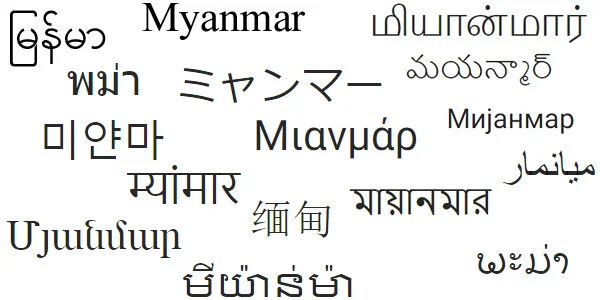Myanmar, or Burma as it formerly was, is a traditionally great, culturally great, and richest of all, linguistically great country. Burmese is the national language of Myanmar, yet the Myanmar language situation is more than one language. It encompasses over 100 ethnic groups and dozens of spoken languages, and, therefore, is the crowning glory of Southeast Asia’s cultural and linguistic diversity. In this article, we discuss the languages of Myanmar, their cultural and historical significance, and the need to preserve their diversity.
Official Language of Myanmar: Burmese
Burmese is the state language and is the most dominant language in ruling, mass media, and schools. It is used by Myanmar’s ethnic Bamar (Burman) ruling class majority and is the lingua franca of the remainder of Myanmar.
Burmese, a Sino-Tibetan language and spoken one, is tonal with a script having roots in ancient Indian Brahmi. It consists of several dialects, but the widely used and spoken is Central Lowland Standard Burmese, spoken near Yangon and Mandalay.
Language Diversity of Myanmar: A Cultural Treasure
Myanmar’s linguistic diversity is closely associated with Myanmar’s highly ethnic character. Myanmar has a total of 135 official ethnic groups, which are grouped under eight major Myanmar language groups: Bamar, Chin, Kachin, Kayah, Kayin, Mon, Rakhine, and Shan. Each of the eight groups has one language or another language designated as its dialect, thereby making its contribution to the total number of Myanmar languages.
Let us look at some of the strongest minority languages of Myanmar:
Major Ethnic and Minority Languages of Myanmar
Shan
Used by Myanmar’s Shan minority who live in eastern parts bordering Thai and Chinese territory, Shan belongs to the Tai-Kadai family of languages. Shan is very similar to Thai and Lao.
Karen (Kayin) Languages
The Karen also possess some satellite languages, which they use to speak so that they can communicate, like Sgaw and Pwo Karen. They are mainly used in southernmost Myanmar and Taiwan, but mainly in Thailand and southeastern Myanmar. They are part of the Sino-Tibetan language but vary in writing system and morphology.
Kachin (Jinghpaw)
Jinghpaw is the dominant Kachin language of northern Myanmar. Also used by very few people in China and India, as well. The Kachin use a Latin script.
Chin Languages
Chin State in Northwest Myanmar hosts an enormous variety of Chin languages such as Hakha, Falam, and Tedim. They belong to the Tibeto-Burman branch and are used by the majority of societies all over the world, though writing systems are under development.
Mon
Mon language, spoken in Mon State and southern Myanmar, is old and one of the oldest writing languages of Southeast Asia. Mon language belongs to the Mon-Khmer (Austroasiatic) language family.
Rakhine
Rakhine or Arakanese is more similar to Burmese, but with a different vocabulary and pronunciation. Rakhine is used in most of Rakhine State.
What are Myanmar’s spoken languages?
National life is Burmese-dominated, yet the country is home to a rich mosaic of languages:
- Burmese (national language)
- Shan
- Karen (Sgaw, Pwo)
- Kachin (Jinghpaw)
- Chin (Hakha, Falam, Tedim)
- Mon
- Rakhine
- Pa’O, Wa, Lisu, Lahu, and hundreds more
It boasts more than 100 languages being spoken throughout the country, a mixture of language families of Sino-Tibetan, Austroasiatic, and Tai-Kadai.
Language Preservation Challenges
With language diversity, there is the potential for endangerment of most of Myanmar’s ethnic languages. Burman dominance of education, displacement within the country, and economic migration have decimated some of the minority languages, especially among children and youth.
They have been documented and preserved by local communities, NGOs, and linguists, but are hampered by resource constraints and political instability.
The Role of Language in Identity
The Myanmar language is not communication; it’s a culture. Any language is the worldview of people, history, and the traditions of people. Whether Mon poetry rhythms or Chin music rhythms, these are the Myanmar ethnic soul.
Final Thoughts
Myanmar languages are a great window into Myanmar’s cultural heritage. From the dominance of Burmese and ethnic languages to the endangered languages, Myanmar’s language diversity is a strength and a weakness.
It must be preserved and encouraged to guarantee Myanmar’s diversity. In the modern world today, local voices become increasingly significant each day.
Let TransLinguist Help You Connect With More Than Languages
TransLinguist appreciates and commemorates language diversity by expert translation and interpreting services for all Myanmar languages. Whether you have education, policy, or culture programs, get in touch now as we translate your message into plain and respectful language.
FAQs
What is the language diversity in Myanmar?
Myanmar has many languages. Over 100 languages are spoken by its different ethnic groups. This is one of the most diverse countries in Southeast Asia.
What languages are spoken in Myanmar?
Burmese is the official language but many others are spoken. Shan, Karen, Kachin, Chin, Mon, and Rakhine are some of them. The languages belong to different familie:s Sino-Tibetan, Austroasiatic, and Tai-Kadai.
What is the cultural background of Myanmar?
Myanmar’s background is all about its ethnic and religious diversity. It’s mainly Buddhism, local customs, and a rich heritage of languages and arts.
What is language diversity in linguistics?
In linguistics, language diversity refers to the quantity of languages in a region. There are structures, vocabularies, and cultural expressions for each language.
What is cultural and linguistic diversity?
Cultural and language diversity refers to numerous cultures and languages within a society. This increases social interaction and provides numerous perceptions and identities.



